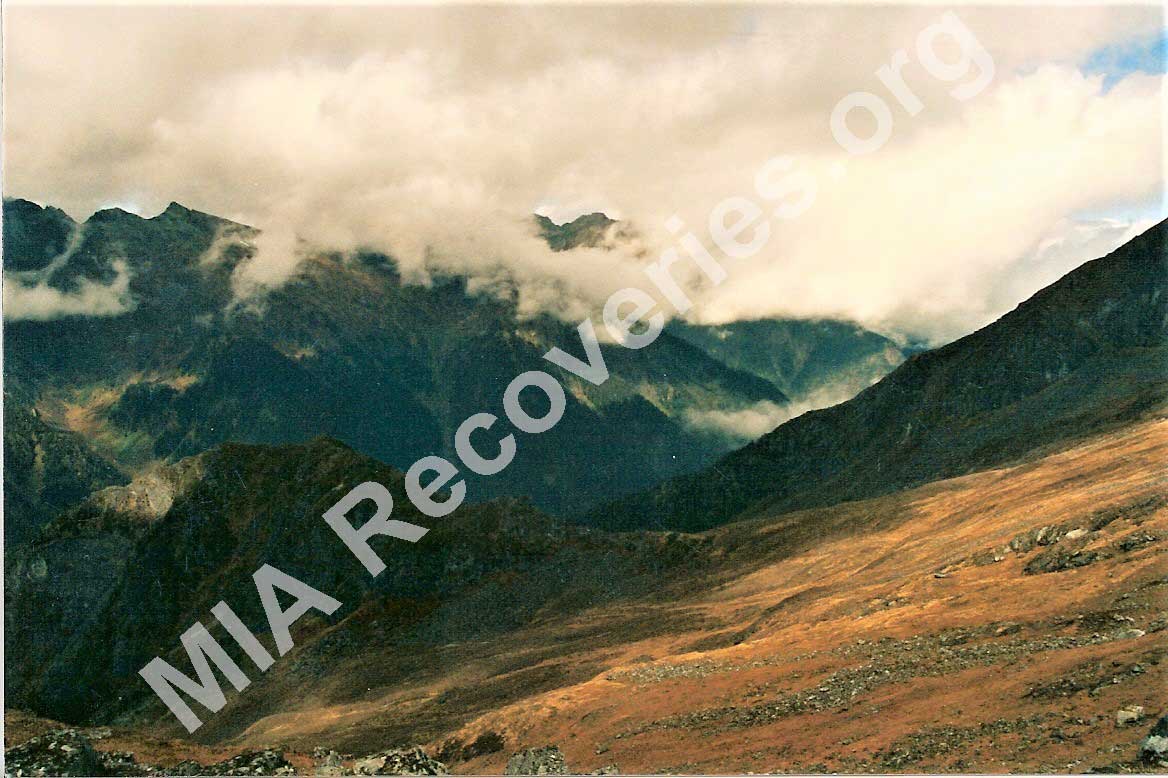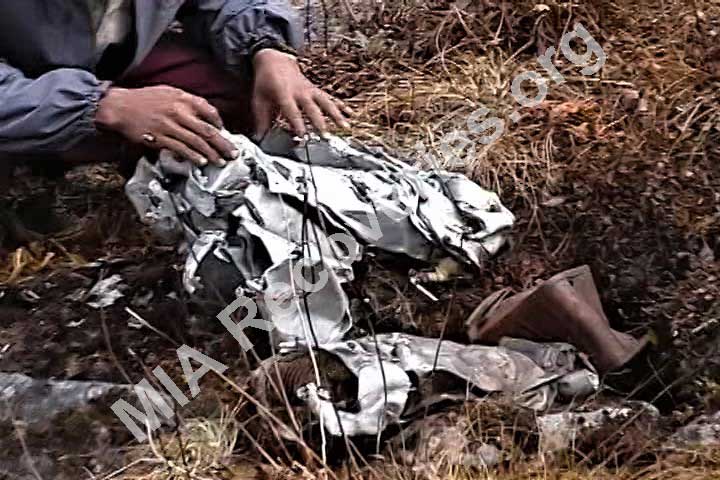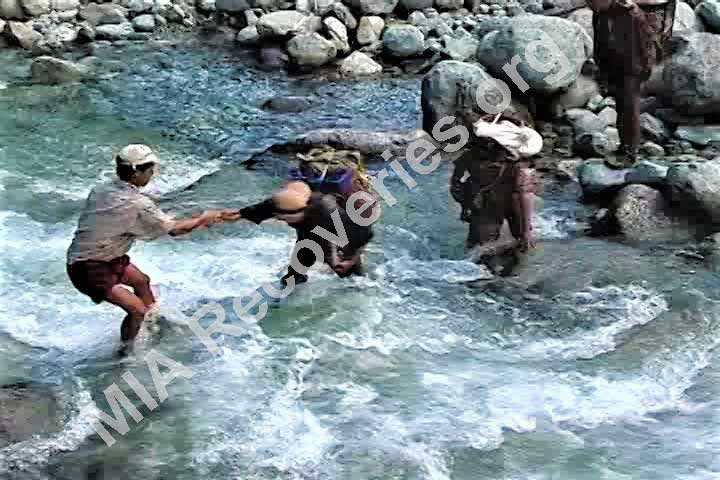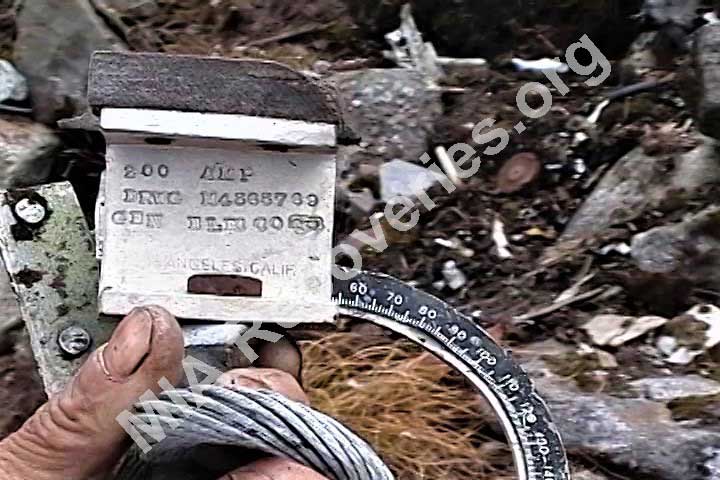How the MIA Search and Recovery Missions Began
Greetings, I’m Clayton Kuhles, the founder and president of MIA Recoveries, Inc.
Some years ago, I was asked by a young family member of an MIA American airman whose remains I had found at the crash site of his C-87 aircraft, high on a remote mountainside in the eastern Himalayas: “What are you?” Not “Who are you?”, but “What are you?” I thought about her unusual question for a few seconds, and then responded to the thoughtful young woman: “I’m a professional adventurer”.
I’ve loved mountain climbing and rugged backcountry adventures ever since I was a young boy spending my summers in the Colorado Rockies with my family. Over the years, I enrolled in mountaineering courses at the Colorado Outward Bound School, and I started climbing mountains worldwide. I’ve climbed major mountains on all the continents. During these many mountaineering expeditions, I witnessed several fellow climbers fall to their deaths, and I personally had two near-death experiences when I fell into hidden crevasses in the Andes Mountains. These sobering experiences, coupled with discussions I had with some of my mountaineering buddies, got me to thinking that I really needed to find a worthwhile and meaningful purpose for my mountaineering adventures… ideally, a purpose that helps other people and helps to make the world a better place for everybody. The “metamorphosis” occurred for me when I was climbing a mountain on the Burma-Tibet border in 2002, and I came upon a missing US aircraft from WWII. When I learned how many of these unsolved “cold cases” there were and how grateful the families were to finally receive some definitive information about their MIA loved ones, I decided to repurpose my mountaineering adventures to this end. To learn more, please view the Origin Story below.
Best regards,
Clayton Kuhles
MIA Recoveries, Inc
Origin Story – How this Humanitarian Project Started
I had been exploring in Burma (Myanmar) every year since 1999 while on my way home after mountaineering expeditions in Nepal and Tibet. I decided to return to Burma in 2002 to climb Hkakabo Razi, which at approx. 19,300 ft. altitude, is known to mountaineers as the highest peak in Southeast Asia. Hkakabo Razi is in far northern Burma, on its border with Tibet.
While at our basecamp on Hkakabo Razi, I noticed two of my Kachin porters talking with each other in their tribal dialect while my Burmese guide and interpreter, Lewin, listened intently to their conversation. Lewin soon came to me and said the Kachin men were talking about something that might be of interest to me. When I asked him what that would be, Lewin responded by asking me if I might be interested in visiting an old aircraft wreck located high in the border mountains to our southwest, along the Burma-India border. He said one of the Kachin men was telling the other Kachin about an aircraft wreck he had heard about from a friend of his. My interest was immediately piqued, and I proceeded to have Lewin ask the Kachin porter many details about the reported aircraft wreck, but the Kachin said he had never been there himself, but only heard about it from his friend Pairem who lives in a tiny Kachin village named Ziadum. I was curious to know whose aircraft it was and why it was flying in such a remote area, so I told Lewin that we would go there to investigate after climbing Hkakabo Razi.

After completing my climb of Hkakabo Razi, we trekked south to the old British colonial police outpost of Ft. Hertz (Putau). There, I paid my porters, hired fresh porters, resupplied with food and started trekking northwesterly towards the village of Ziadum on the border with India. We trekked for days and eventually reached Ziadum and found Pairem, the local Kachin man who had reportedly been to the aircraft crash site. From his hut, he pointed to the summit ridge of the nearby mountain range forming the border between Burma and India, and said the aircraft wreckage was located in a rocky ravine just below the summit ridge, between two prominent buttes.
We waited at his hut for a couple days while an early snow melted off the upper area of the mountain range. After a rugged 3-day trek to the WNW, fording swollen rivers and cutting our way through thick jungle, we eventually reached the upper slopes of the mountain and then out onto the rocky area just below the summit ridge. Sure enough, there was the smashed wreckage of a C-47 aircraft, probably from WW II. I removed some data plates and documented the wreckage as well as I could, but I didn’t have a GPS receiver with me.
We then trekked back to Ft. Hertz, where I paid my porters, and then I made my way south to Rangoon and to the US Embassy there. At the Embassy, I met with the Assistant Defense Attache, an Air Force major named James McAndrew. James listened to my story and examined the wreckage artifacts I had brought with me, and he informed me that I had probably discovered one of the hundreds of US aircraft lost on the notorious Hump route during WW II. At the time, I had never heard of the Hump. I was completely unaware of how many US aircraft and airmen disappeared while transporting war supplies over the eastern end of the Himalayas from their airbases in northeastern India into China to support the battle against the occupying Japanese Imperial Army. James asked me to return to the wreckage site and get the GPS coordinates, so I agreed to return the following year.

Back home in the US, I read everything I could find about the Hump airlift and I started attending the annual reunions of the Hump airmen to meet and interview them and listen to their stories of dangerous Hump flights. They told of empty chairs in the mess hall after those airmen didn’t return from their last Hump mission. The Hump airmen were so happy to hear that I had found one of their missing aircraft from so long ago. I was shocked to learn how many aircraft crashed and how many airmen became MIA on the Hump, but absolutely astounded to learn that nobody had ever gone back to systematically search for them after WW II. Many of the MIA airmen were described as “Unrecoverable” in the archival reports I obtained. It seemed like recovering the MIA Hump airmen was officially regarded as a Mission: Impossible and for practical reasons they had to be written-off since it would be too difficult to find them. As a mountaineer, I’m magnetically attracted to “impossible” missions, so after attending a China National Aviation Corporation (CNAC) Assoc. reunion and interviewing more of the elderly airmen, I decided to refocus my love of mountaineering adventures towards finding and recovering our MIA’s, specializing in the former China-Burma-India theater and its dangerous Hump route, where hundreds of US aircraft crashed with the loss of perhaps more than 2,000 airmen and their passengers.
I returned to Burma in 2003 and rehired Pairem, the Kachin villager and hunter who had guided me to the C-47 crash site in 2002. The plan was to return to the C-47 site and record its GPS coordinates. Pairem then told me about another old aircraft wreck he had been to some years previous, across the border in a very remote and mountainous area of northeastern India. He said it was so remote there was very little chance of us being caught by an Indian Army patrol.
Pairem recommended we go to the aircraft crash site in India first, then revisit the C-47 site on our return to his village. I enthusiastically accepted his suggested expedition itinerary, but my Burmese guide and interpreter, Lewin, was very nervous about making an illegal border crossing into India. When I said I would leave him in Ziadum and cross into India with the Kachin team and communicate with them using sign language, Lewin ultimately relented and we agreed to set off as a unified team across the border mountains into India. We increased our food supplies for the trip into India and hired additional Kachin porters in Ziadum to carry the extra food since there would be no opportunity to resupply in that remote corner of India. We wanted to avoid coming into contact with anybody in India since we would be entering illegally and didn’t want to draw attention to ourselves.
After a week of rugged mountain trekking and many hazardous river crossings, we neared the area where Pairem remembered seeing the aircraft wreckage. Along the way, he had stopped and hesitated many times as if he was unsure of the crash site location and the route to reach it. We eventually reached a location in the Tapum River Valley where Pairem said we should establish our high camp, as this was near the last water source before reaching the crash site further up the mountain. The Tapum River flows NNW to join the Ghalum River, which flows WSW to join the Kallong River, which flows NW to join the Lohit River at Minzong/Samdul (S of Walong).
The following morning, we trekked further up the mountain in search of the aircraft wreckage. Again, Pairem seemed hesitant and unsure of himself. We searched all day and found nothing, and whenever I asked Pairem for any location details that he could recall, I just received a blank stare from him in response. I was becoming somewhat annoyed and privately musing that perhaps Pairem was leading me on a pointless trek just so he could charge me for his guiding services. We decided to end our search efforts for the day and head back down the mountain to our campsite. The next morning, we resumed our search high up on the mountainside, but by late afternoon we still hadn’t found the aircraft wreckage or any trace of it. Finally, I vented my frustration on Pairem by asking him if he really knew the location of the wreckage or was this just a scam to lead me around looking for a nonexistent aircraft wreck so he could charge me guiding fees. Of course, this had to be communicated to Pairem through Lewin, since Pairem only spoke the Kachin dialect.

He response was swift. He immediately unshouldered his homemade .50 cal. shotgun and held it at the ready with both hands, and then calmly said: “Well, I have the only gun here, so what are you going to do about it?” I instantly responded: “I’ll tell you what I’m going to do about it! Nobody is leaving here and nobody is going to get paid until we find that aircraft wreck that you’ve been telling me about!” After that tense verbal exchange, I announced that I was heading down to our high camp to brew some tea, and I departed before the situation ratcheted further out-of-control. Pairem continued searching high on the mountainside. I had barely finished brewing my tea when a porter came running down the mountain shouting: “Mr. Clay! Mr. Clay! We find airplane! We find airplane!” I abandoned my tea and hurriedly followed the porter back up the mountain in the rapidly developing dusk. There it was! It was on an open, grassy slope and just a little to the north of where we had been searching that day. The impact zone was small… with most of the wreckage concentrated in an area not much larger than .25 acre. Almost all the wreckage was shattered into small pieces and some pieces were driven deep into the ground. It seemed evident to me the aircraft had probably gone into a stall and spun-in, impacting the ground at a near-vertical angle. It would have been impossible to see the wreckage from any significant distance if viewed laterally across the ground surface. A person would almost have to be standing on it or viewing it from above to see it.
We returned to the crash site the following day. The first thing I did upon reaching the site was to request Pairem and the other Kachin personnel not to remove any wreckage from the site, but to leave everything in-place so I could properly document the site. We then set to work searching the site for any evidence that could help ID the aircraft, and thus ID the crewmembers who were aboard. We readily found many human remains and personal artifacts laying on the ground surface, but we couldn’t find any numbers that could be used to ID the aircraft. Pieces of leather gloves, boots, shoes and flight jackets were amazingly preserved after laying fully exposed to the weather for many decades. By dusk, we still hadn’t found any useful numbers to ID the aircraft, and I now had to accept the possibility that after expending all this time, effort and money (my personal money), we might never know the ID of the crewmembers because we couldn’t ID the aircraft. I felt devastated! I had already gathered all the human remains we could find on the ground surface and placed them in a nylon stuffsack I normally used for my sleeping bag, and some personal artifacts and wreckage artifacts were placed in another nylon stuffsack that otherwise would store my sleeping pad. With darkness upon us, we abandoned the search for identifying evidence and tiredly trekked down the mountain to our high camp. I knew we didn’t have enough food to stay any longer at the site and we would need to leave for Burma the following morning.
That evening, we sat around the campfire and discussed plans to break camp in the morning and trek back to Burma, and revisiting the C-47 crash site from 2002 before returning to Ziadum. Pairem was seated directly to my right on a log sipping his tea, when I noticed he was fumbling around in his left shirt pocket as if trying to extract a cigarette. Instead of a crumpled cigarette, Pairem extracted a crumpled piece of metal that he had obviously collected from the crash site. I was annoyed by this and I heatedly asked Pairem why he had removed an artifact from the site after I had specifically requested everybody not to remove anything. Then I said: “Here, let me see that”. To my utter amazement, Pairem (who couldn’t read English) had found and pocketed the aircraft data plate… an all-important, but small stainless steel plate measuring only about 1 inch tall X 4 inches wide and stamped with the aircraft model number, serial number and date of manufacture. I could hardly believe my eyes! Pairem’s discovery and pocketing of this vital artifact had literally saved my expedition by enabling me to positively ID the aircraft and thus ID the crewmembers. I gave Pairem a big hug and repeatedly apologized to him for doubting his ability to find the crash site. When you think about it, it was a miracle that the aircraft data plate could even be found amongst the mangled wreckage, then pocketed by Pairem after being requested not to remove anything from the crash site, and finally, I had the good fortune to see him with it. I never learned why Pairem collected it. Was it because he sensed the key importance of this small piece of metal to the expedition, or did he just like the way it looked? Whatever his reasoning was, it was definitely a fortuitous chain of events!

The next morning, we broke camp and started the arduous trek back over the mountain ranges to Burma. Shortly after crossing into Burma, we made a slight diversion to revisit the C-47 crash site that I first reached in 2002. After completing my documentation of this site, we proceeded down the mountain and into Ziadum. After a day’s rest in Parem’s hut, and paying the porters I had hired in Ziadum, my remaining porters and I started trekking back to Ft. Hertz.
As my team and I approached Ft. Hertz, I gathered them around me and explained through Lewin that Burmese Military Intelligence (MI) officers surely knew of my presence in the area and were probably curious about where we went and why we went there. I warned the team there was a possibility that we would each be visited by an MI officer shortly after returning to Ft. Hertz and we would be individually interrogated, so it was important we develop and adhere to a uniform “story” to tell them. We had to assume MI would quickly learn about the human remains and artifacts I carried in my bags, so we should all say we found the items on a hillside not far from Ft. Hertz, but definitely don’t mention crossing the border into India. Admitting to an illegal border crossing could lead to our collective arrests and detention in jail.
Lewin and I were actually concerned that MI had already planted an informant amongst our porters before we left Ft. Hertz weeks ago. In which case, we (or least, Lewin and I) were already headed for a Burmese jail cell. Lewin and I had to spend several days waiting in Ft. Hertz to catch the once-weekly flight down to Myitkyina. Oddly, the only place for us to stay was a guest bungalow on the Burmese Army base, just feet away from their radio shack. I would have to overnight in Myitkyina to catch a connecting flight down to Mandalay and finally down to Rangoon. Assistant Defense Attache Maj. James McAndrew had earlier told me he would be in Myitkyina at about that time, and I should stop by his guest house and have a beer with him when I arrived in town.
Upon arriving at the Ft. Hertz airport on flight day, I immediately noticed a large contingent of MI officers eyeing me in a very serious manner. This gave me a sinking feeling, but I already expected as much and I would just have to deal with whatever happened next. As expected, I was held back while all the other passengers were processed and allowed to board the aircraft sitting on the sweltering tarmac. Then the airport workers rolled the stairs away from the aircraft while I was still sitting in the airport building. This was a good indication of what was about to happen next, I thought. Then the MI officers signaled me to come forward and empty my duffle bags and backpack onto their inspection table. The interrogation began. They asked me dozens of times where I had found the human remains and personal artifacts now laying before them, and I repeatedly answered them with my “story”. The lead MI officer then called his commander on his mobile phone and talked for what seemed like an eternity. The phone call finally ended, and he abruptly announced that I was free to board the waiting aircraft, but the human remains and personal artifacts would be retained by MI. Of course, I was greatly relieved to be allowed to leave, but what about the crewmember remains and personal artifacts?! My brain was working furiously trying to think of a way I could ultimately get my precious cargo delivered to the US Embassy in Rangoon. The MI officer politely wrote a longhand receipt for everything they confiscated from me, we both signed the receipt, and he gave me the original while retaining a photocopy for their file. Not wanting to miss my golden opportunity to avoid a Burmese jail cell, I quickly exited the building and boarded the waiting aircraft. The other passengers were local Burmese, and they did everything possible to avoid looking at me, perhaps for fear of somehow being connected to me and then being taken off the aircraft for interrogation (which probably wouldn’t be as courteous and gentle as my interrogation was).
I quickly found Maj. McAndrew when I reached Myitkyina, and he was laughing uproariously as I approached. As James explained it, he was already fully aware of everything that happened to me up at Ft. Hertz, because he speaks fluent Burmese and he was standing next to the MI commander when he received the call from his officer at the Ft. Hertz airport during my interrogation.
James said he would have had the US Embassy take immediate action to get me released had the MI commander ordered my arrest, but instead, he just listened to the MI conversation and kept his mouth shut. James assured me they have a good working relationship with the MI commander and everything would probably be delivered to the US Embassy within a reasonable time. I gave James the signed receipt for the retained items and we went out for some beers and food.
About a month or so later, the retained items were delivered to the US Embassy in Rangoon and then subsequently transferred to the JPAC forensics lab at Pearl Harbor. I visited the JPAC facility in early 2004 to personally verify that all the items confiscated from me at Ft. Hertz were now present and accounted for. The JPAC staff allowed me to take the wreckage artifacts with me (except for the aircraft data plate) and I sent those artifacts to the family members of the crewmembers.
Of the crewmember remains I carried out from India, 3 of the 5 airmen aboard this aircraft were subsequently identified through DNA and returned to their families for burial. The recovered airmen were:
Pilot: Capt. Jennings H. Mease, Sr.
Co-Pilot: 2nd Lt. Samuel E. Lunday, Jr.
Flight Engineer: Pvt. Mervyn E. Sims
View the Crashed Aircraft Site Report for C-87 #41-23696
These expedition notes were prepared by Clayton Kuhles, the founder and president of MIA Recoveries, Inc.
Important Notice: These MIA missions are mostly self-funded by Clayton Kuhles. No funding support is received from the US government. If you believe this is a worthwhile humanitarian project that needs to be pursued, then please visit the Funding page on this website to see how easy it is to support this project in a meaningful manner. MIA Recoveries, Inc is a tax-exempt public charity under Section 501(c)(3) of the Internal Revenue Code. Funding donations to MIA Recoveries, Inc are deductible under Section 170 of the Code. EIN: 45-3174718